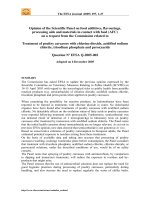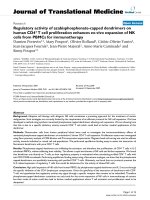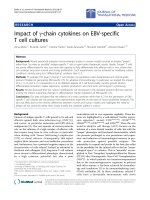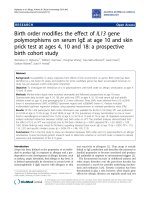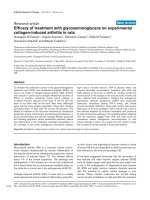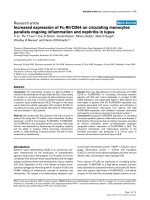Therapeutic efficacy of indigenous polyherbal formulation on milk PH, somatic cell count and electrical resistance profile in healthy and subclinical mastitic dairy cows
Bạn đang xem bản rút gọn của tài liệu. Xem và tải ngay bản đầy đủ của tài liệu tại đây (238.31 KB, 8 trang )
Int.J.Curr.Microbiol.App.Sci (2019) 8(10): 703-710
International Journal of Current Microbiology and Applied Sciences
ISSN: 2319-7706 Volume 8 Number 10 (2019)
Journal homepage:
Original Research Article
/>
Therapeutic Efficacy of Indigenous Polyherbal Formulation on Milk pH,
Somatic Cell Count and Electrical Resistance Profile in Healthy and
Subclinical Mastitic Dairy Cows
Komal Singh1, Krishna Kr. Mishra1, Neeraj Shrivastav2, Santosh Kr. Mishra3, Anil Kr.
Singh4, Amit Kr. Jha5, Namrata Tiwari1 and Rajeev Ranjan6*
1
Department of Veterinary Medicine, 2Department of Veterinary Microbiology, 4Department
of Veterinary Physiology & Biochemistry, 5Department of Animal Genetics & Animal
Breeding, 6Department of Veterinary Pharmacology & Toxicology, College of Veterinary
Science & A.H., Rewa, Madhya Pradesh, India
3
Department of Dairy Microbiology, College of Dairy Science & Technology, GADVASU,
Ludhiana, Punjab, India
*Corresponding author
ABSTRACT
Keywords
Subclinical mastitis,
Herbal, Milk, pH,
Somatic cell count
and electrical
resistance
Article Info
Accepted:
07 September 2019
Available Online:
10 October 2019
The present study was conducted to detect subclinical mastitis from milk and also
to evaluate the therapeutic efficacy of the indigenous polyherbal formulation.
Twenty four lactating cow suffering from subclinical mastitis (SCM) were
randomly divided into four treatment groups G-II to G-V, whereas G-I comprised
of six apparently healthy cows. G-II did not receive any treatment and served as
the positive control. G-III was provided with standard therapy with Amoxicillin
and Cloxacillin @ 10mg/kg bwt I/M along with Meloxicam @ 0.5 mg/kg bwt I/M
for 3 days. G-IV was administered with 5 gm each from Azardirachta indica,
Boswellia serrata, Vitex nigundo, Ocimum sanctum and Tinospora cordifolia
herbal powder @ 25 gm orally for 5 days. Group-V was treated with group III and
IV combination therapy. The Somatic Cell Count (SCC) in G-IV to G-V was
significantly reduced on 10th day of post-treatment. Similarly, electrical
conductivity (ER) was significantly reduced on 7th day, which was further reduced
on 10th day. The combined treatment was most effective in the reduction of ER on
7 and 10th day of post-treatments as compared to herbal treatment alone. In
addition, the antibiotic treatment reduced the pH significantly on 7 th day, while in
combination therapy, it was reduced significantly on 3rd day onward. Hence,
herbal treatment along with standard treatment was most effective in the
amelioration of pH, somatic cell count and electrical resistance as compared to
standard treatment or herbal treatment when given alone.
703
Int.J.Curr.Microbiol.App.Sci (2019) 8(10): 703-710
Introduction
Livestock plays a vital role in the Indian
economy and in the socio-economic
development of the country. These livestock
sectors also play an important role in
supplementing family incomes and generating
gainful employment in the rural sector,
particularly, among the small and marginal
farmers, women and landless laborers. They
are providing cheap nutritional food to
millions of people. Mastitis is a common and
multi-etiological complex disease affecting all
milk-producing animals (Lu et al., 2008).
It caused an inflammation of the parenchyma
of mammary glands and characterized by
physical, chemical and bacteriological
changes in milk and pathological changes in
mammary gland tissues (Radostits et al.,
2000).
The infection is transmitted by milkcontaminated fomites at milking, by the
Milker’s hands, or by the milking machine.
Environmental mastitis transmitted by contact
of the teats with contaminated soil, bedding
and water with fecal materials (Barua et al.,
2014; Mir et al., 2014).
the past few decades, a large quantity of
research has been focused on characterizing
the antibacterial effects of different herbs and
aromatic plants and many other natural
substances for the treatment of different
animal diseases including mastitis (Baskaran
et al., 2009; Nurdin et al., 2011).
The objectives of this study were to assess the
effects of Azardirachta indica, Vitex Nigundo,
Ocimum sanctum, Tinospora cordifolia and
Boswellia serrata on milk pH, somatic cell
count and electrical resistance profile in
healthy and as well as mastitis-affected dairy
cattle.
Materials and Methods
Experimental animals
The suspected cases of subclinical mastitis
was screened for the study from those
presented to Medicine Out Patient Department
(OPD) of Teaching Veterinary Clinical
Complex (TVCC) and Instructional Dairy
Farm of college along with private dairies and
Goushalas of Rewa district, Madhya Pradesh
during June 2018 to July 2019.
Plant Material
It’s considered of quite vital importance to
public health due to its association with many
zoonotic diseases in which the milk act as a
vehicle for some infectious agents (Ahmady
and Kazemi, 2013). Antibiotics have been the
mainstay for mastitis prevention programs and
treatment for decades.
The use of antibiotics has been accompanied
by the appearance of resistant strains of
common bacterial species in dairy animals
(Gao et al., 2012).
This rising to alarming concerned that led to
the urgency of finding new and innovative
treatment options for mastitis worldwide. In
The part of herbs like Azardirachta indica
(Neem/Indian lilac/Margosa), Vitex Nigundo
(Nirgundi/Chinese Chaste Tree), Ocimum
sanctum (Tulsi /Holy Basil), Tinospora
cordifolia
(Giloy/Guduchi
/Heart-leaved
moonseed) and Boswellia serrata (Salai
/Guggul/Shallaki/Indian Frankincense) were
purchased from registered herbal shops from
Rewa, Madhya Pradesh.
Diagnosis of subclinical mastitis
The cows were screened for sub clinical
mastitis (SCM) by performing California
Mastitis Test (CMT).
704
Int.J.Curr.Microbiol.App.Sci (2019) 8(10): 703-710
Experimental group
Twenty four lactating cows suffering from
subclinical mastitis (SCM) were randomly
divided into four treatment groups i.e. Group
II to Group V (n=6) whereas, Group-I
comprise of six apparently healthy cows was
taken for comparison. Subclinical mastitis
cows of Group-II were kept as an untreated
control and Group-III of SCM cow was
treated with Amoxicillin and Cloxaxillin @ 10
mg/kg bwt I/M along with Meloxicam @ 0.5
mg/kg bwt I/M for 3 days. Group-IV of SCM
cows was treated with herbal preparation
which contains 5 gm leaves of Azardirachta
indica, 5 gm leaves of Vitex Nigundo, 5 gm
Leaves of Ocimum sanctum, 5 gm bark of
Tinospora cordifolia and 5 gm Gum resin of
Boswellia serrata. Total 25 gm of powder
preparation was given orally twice daily for 5
days. Group-V was treated with both standard
treatment as well as herbal preparation (Group
III and IV combination treatment).
Collection of milk samples
The milk samples from affected quarters from
each cow were collected after proper
disinfection of teat surface. The udder and
teats were cleaned and washed with potassium
permanganate 0.01 % then wiped with clean
cloth. First few streams of foremilk was
discarded and then about 8 ml of milk from
each affected quarter was collected in fresh,
sterile, labeled screw cap test tubes and
brought to the department in ice for further
examination. Milk sample was collected on
‘0’ day (pretreatment) and subsequently on
3rd, 5th, 7th and 10th day.
Testing of milk samples
California Mastitis Test (CMT)
California Mastitis Test (CMT) was conducted
for the identification of Clinical and Sub
clinical mastitis in cattle (Ruegg and
Reinemann, 2002). The milk from the four
quarters was collected in the CMT paddle
after discarding first stripping of the milk. The
paddle was tilted so that the excess milk was
drained off and all the cups in the paddle
contained equal amount of milk. The CMT
reagent was added to the all the cups equal to
the amount of milk already contained in the
cups representing the four quarters. The
paddle gently swirled and the CMT score was
read.
Milk pH
Milk pH was estimated by the digital pH
meter. The pH reading of the normal and
mastitis milk sample was recorded on 0 day
(pre treatment) and on 3rd, 5th, 7th and 10th day
(post treatment).
Electrical resistance (ER)
Draminski Mastitis Detector was used to
measures the electrical resistance of milk to
detect subclinical mastitis. A minimum of 15
ml of the first portion of milk was poured
directly from the teat to measuring cup. Then
the switch on button was pressed to read the
result in units. After recording the milk was
poured out and the steps were repeated for
other quarters. The electrodes were cleaned
with methylated spirit by a clean cloth or
tissue. A reading below 300 units was
considered as the cut-off value for subclinical
mastitis and above 300 was considered as
healthy (Siddiquee et al., 2013).
Somatic Cell Count (SCC)
The somatic cell count (SCC) of milk samples
was calculated as described by Schalm et al.,
(1971) and the milk smear were stained with
Newman- Lumpert stain. Milk sample was
thoroughly mixed, so that to obtain uniform
distribution of cells. Milk smears (0.01 ml
705
Int.J.Curr.Microbiol.App.Sci (2019) 8(10): 703-710
milk for each smear) was prepared on grease
free glass slide with the help of a platinum
loop. The slides were air dried and preserved
till staining was done. Slides were immersed
for 20 seconds in Newman - Lampert stain.
Excess of stain was drained off and slides
were air dried. Then the slides were rinsed two
or three times in water and rapidly air dried
after draining by gentle blotting with filter
paper. The smears were stained deep blue.
Calibration was done in four one square cm
areas. The leukocyte count in the subclinical
mastitis milk was performed to assess the
degree of infection using Newman's - Lumpert
stain as per the procedure described by
Harmon (2001).
Haggag et al., (1991) who showed that with
severity of mastitis pH of the samples
increased. Similarly, Charjan et al., (2000)
reported that milk pH increased in could serve
as the best indicator to assess the condition of
udder health in dairy animals.
Normal fresh milk has approximately a pH 6.6
to 6.9, which indicates that the milk is slightly
acidic. The probable reason of increase pH
due to severity of mastitis may be attributed to
the lowered acidity as has been found in
mastitis milk. The lowered acidity in mastitis
milk is due to reduction in lactose contents as
the lactic acid formation is minimum in this
case (Haggag et al., 1991; Bilal and Ahmad,
2004).
Statistical analysis
Data are presented in Means ±Standard Error.
The data was analyzed using statistical tools
(SPSS version 20). Repeated measures
ANOVA was used for pre and post treatment
multiple comparisons. ANOVA followed by
Duncan’s Multiple Range Test was used for
multiple comparisons. Statistical differences
were determined at the 5% level of
significance.
Results and Discussion
pH before and after treatment
Mean±SE value of milk pH was 6.57±0.04 to
6.68±0.05 in healthy control group (G-1) and
7.53±0.04 to 7.60±0.04 in negative control
group (G-II) indicate milk pH increased due to
mastitis (Table 1). Statistical analysis
indicated a highly significant (p<0.05)
difference in pH due to severity of mastitis. In
treatment G-III to V indicate a significant
reduction in pH during the course of treatment
from day 0 to 10th day.
The results of the present study are in
agreement with Horvath et al., (1980) and
Electrical Resistance (ER) before and after
treatment
Mean±SE value of milk ER was 356.67±13.33
to 371.67±13.02 in the healthy control group
(G-1) and 295.00±13.84 to 315.00±19.45 in
the negative control group (G-II) indicate milk
ER decreased due to mastitis (Table 2).
Statistical analysis indicated a highly
significant (p<0.05) decreased in ER due to
severity of mastitis. In treatment G-III to V
indicate a significant (p<0.05) increased in ER
during the course of treatment from day 0 to
10th day. However, the best result observed
after 5th day onward in treatment group.
In this study, the electrical resistance (ER) was
measured instead of electrical conductivity
(EC) which gave an indirect estimate of EC.
Electrical conductivity of milk was reciprocal
to electrical resistance of milk. EC is the
measured by the presence of ions (Ilie et al.,
2010). Milk has conductive properties as it is
enrich compound especially mineral salts such
as sodium, chloride, potassium, calcium,
magnesium and other ions (Mucchetti et al.,
1993; Norberg, 2005).
706
Int.J.Curr.Microbiol.App.Sci (2019) 8(10): 703-710
Table.1 pH of the healthy and SCM positive animals before and after the treatment
Day
0
3
5
7
10
G-1
6.57±0.04a
A
6.62±0.06a
A
6.68±0.05b
A
6.62±0.05b
A
6.65±0.06 b
G-II
7.55±0.04c
A
7.55±0.04c
A
7.53±0.04d
A
7.60±0.04d
A
7.57±0.04d
A
G-III
6.95±0.02b
C
6.98±0.05b
BC
6.90±0.03c
A
6.75±0.04b
AB
6.85±0.04bc
A
G-IV
7.08±0.08b
A
7.08±0.15b
A
7.03±0.10c
A
6.90±0.07c
A
6.90±0.15c
BC
A
G-V
6.50±0.00a
A
6.40±0.04a
A
6.40±0.03a
A
6.37±0.04a
A
6.37±0.03a
B
Values (Mean±SE) bearing different superscript in capital and small letter differ significantly in column and row
respectively (p<0.05).
Table.2 Electrical Resistance of the healthy and SCM positive animals before and after the
treatment.
Day
0
3
5
7
10
G-1
356.67±13.33b
A
363.33±15.20b
A
370.00±12.91b
A
371.67±13.02c
A
370.00±18.26b
A
G-II
315.00±19.45ab
A
311.67±17.40a
A
308.33±20.23a
A
295.00±13.84a
A
296.67±10.22a
A
G-III
287.33±15.76a
AB
312.50±13.77a
B
333.00±13.55ab
B
331.67±14.47abc
B
341.67±14.47ab
A
G-IV
300.67±17.94a
A
288.33±13.02a
AB
330.00±12.91ab
AB
328.33±10.14ab
B
346.67±16.06b
A
G-V
283.33±12.02a
AB
310.33±15.75a
ABC
325.00±12.04ab
BC
341.67±14.47bc
C
361.67±17.21b
A
Values (Mean±SE) bearing different superscript in capital and small letter differ significantly in column and row
respectively (p<0.05).
Table.3 Somatic cell count (nx105) of the healthy and SCM positive animals before and after the
treatment
Day
0
3
5
7
10
G-1
1.52±0.12a
A
1.49±0.11a
A
1.28±0.09a
A
1.33±0.11a
A
1.44±0.15a
A
G-II
17.22±3.12b
A
19.78±4.99b
A
29.68±5.97b
A
33.23±7.06b
A
30.15±5.67 b
A
G-III
18.05±5.68b
B
17.18±3.12b
AB
14.30±2.43a
AB
8.47±2.31a
A
4.87±0.83a
B
G-IV
18.73±2.62b
AB
16.35±1.94b
AB
11.27±6.64a
A
6.97±2.03a
A
5.35±2.32 a
B
G-V
19.77±6.46b
AB
13.43±1.78b
AB
11.13±6.51a
AB
8.61±2.23a
A
4.48±1.02a
B
Values (Mean±SE) bearing different superscript in capital and small letter differ significantly in column and row
respectively (p<0.05).
The results of the present study are in
agreement with Hussain et al., (2012) and
Gaspardy et al., (2012) who showed that
higher values of electrical conductivity in
mastitis animals might be due to the presence
of clinical and subclinical infection and could
be used as an adjunct test for diagnosis of
mastitis in animals along with other available
tests.
Norberg et al., (2004) indicate that cows with
mastitis may not always show an increased
electrical conductivity of milk from the
infected quarter, but the variation in EC of
milk from infected quarters may be larger than
variation in EC of milk from healthy quarters.
The ionic changes that occur during
inflammation as a result of increased sodium
and chloride concentrations in mastitis milk
might be responsible for the alterations in
electrical conductivity/resistance (Popovic,
2004).
707
Int.J.Curr.Microbiol.App.Sci (2019) 8(10): 703-710
The concentration of Na⁺ and Cl¯ ions is
increased and concentration of K+ and lactose
is decreased when the cows and buffalos were
suffering with mastitis due to inflammation of
udder, hence increase the EC. Although EC is
also affected by some other factors such as
bread, lactation stage and milking interval
(Kamal et al., 2014).
Somatic Cell Count (SCC) before and after
treatment
Mean±SE value (nx105 somatic cells/ml) of
milk SCC was 1.28±0.09 to 1.52±0.12 in the
healthy control group (G-1) and 17.22±3.12 to
33.23±7.06 in the negative control group (GII) indicate milk SCC increased due to mastitis
(Table 3).
Statistical analysis indicated a highly
significant difference in SCC due to severity
of mastitis. In treatment G-III to V indicate a
significant increased in SCC during the course
of treatment from day 0 to 10th day. The
combination therapy (G-V) give the best result
a significant (p<0.05) reduction was found
only on 10th day.
The major factor affecting the SCC at the herd
and individual level is the presence of
intramammary infections (Radostits, 2007).
Normal milk from uninfected quarters
generally contains < 2x105 somatic cells/ml.
The rise in the leukocyte number in milk and
in the mammary gland might be due to the
pathogens or to their metabolites which lead to
an increase in somatic cell count (Harmon,
1994; Atasever, 2012).
The high SCC content in infected quarters as
compared with uninfected quarters was similar
to that reported by previous studies
(Bruckmaier et al., 2004; Bonfoh et al., 2005).
It could be concluded that the feeding of
polyherbal formulation to SCM infected dairy
cows showed improvement in the pH, Somatic
Cell Count and Electrical resistance profile of
milk. It indicated that polyherbal therapy
potentiates the udder immunity, not only
eliminates udder infection in subclinical
mastitis but also control the mastitis without
any side effects.
It also augments repair of mammary gland,
firmness and normalizes udder functioning
with improved milk quality. Thus polyherbal
formulation may be recommended for the
prevention and treatment of subclinical
Mastitis in bovines.
Acknowledgment
We are thankful to College of Veterinary
Science & A.H., Rewa (NDVASU, Jabalpur),
Madhya Pradesh for providing the necessary
facilities to conduct the research.
References
Ahmady, M. and Kazemi, S. 2013. Detection
of the enterotoxigenic genes (sei, sej)
in Staphylococcus aureus isolates from
bovine mastitis milk in the West
Azerbaijan of Iran. Comp. Clin.
Pathol., 22(4): 649-654.
Atasever, S. 2012. Estimation of correlation
between somatic cell count and
coagulation score of bovine milk. Int.
J. Agric. Biol., 14: 315-317.
Barua, M., Prodhan, M.A.M., Islam, K.,
Chowdhury, S., Hasanuzzaman, M.,
Imtiaz, M.A. and Das, G.B. 2014.
Seasonal effects on milk yield,
erythrocytic and leukocytic indices of
Kankrej cattle (Bos indicus). Vet.
World, 7: 483-488.
Baskaran, S.A., Kazmer, G.W., Hinckley, L.,
Andrew, S.M. and Venkitanarayanan,
K. 2009. Antibacterial effect of plantderived antimicrobials on major
bacterial mastitis pathogens in vitro. J.
Dairy Sci., 92: 1423-1429.
708
Int.J.Curr.Microbiol.App.Sci (2019) 8(10): 703-710
Bilal, M.O. and Ahmad. A. 2004. Dairy
Hygiene and Disease Prevention.
Usman and Bilal Printing Linkers,
Faisalabad, Pakistan.
Bonfoh, B., Zinsstag, J., Farah, Z., Simbe,
C.F., Alfaroukh, I.O., Aebi, R.,
Badertscher, R., Collomb, M., Meyer,
J. and Rehberger, B. 2005. Raw milk
composition of Malian Zebu cows
(Bos indicus) raised under traditional
system. Int. Dairy J., 18: 29-38.
Bruckmaier, M., Ontsouka, E. and Blum, W.
2004. Fractionized milk composition
in dairy cows with subclinical mastitis.
Vet. Med. Czech. 49: 283-290.
Charjan-Ku, P.Y., Mangle, N.S., Kalorey,
D.R. and Kuralkar. S.V. 2000.
Changes in milk pH and the levels of
Na and K in whey associated with
udder health status of cow. Indian
Veterinary J. 77(12): 1066-1068.
Gao, J., Yu, F.Q., Luo, L.P., He, J.Z., Hou,
R.H., Zhang, H.Q., Li, S.M., Su, J.L.
and Han, B. 2012. Antibiotic resistance
of Streptococcus agalactiae from cows
with mastitis. Vet. J., 194: 423-424.
Haggag, H.F., Hamzawi, L.F., Mahran, G.A.
and Ali. M.M. 1991. Physico-chemical
properties of colostrums and clinical
and sub-clinical mastitic buffalo milk.
Egyptian J. Dairy Sci., 19(1): 55-63.
Harmon, R.J. 1994. Physiology of mastitis and
factors affecting somatic cell count. J.
Dairy Sci. 77: 2103-2112.
Horvath, G.A., Mohammed, H., Varga, J.,
Szemeredi, G. and Quarini. L. 1980.
Effect of subclinical mastitis on milk
composition. Magy. Allatorvosok
Lapja, 35(9): 615-619.
Hussain, R., Javed, M.T. and Khan, A. 2012.
Changes
in
some
biochemical
parameters and somatic cell counts in
the milk of buffalo and cattle suffering
from mastitis. Pak. Vet. J., 32: 418421.
Ilie, L.I., Tudor, L, Galis, A.M. 2010. The
electrical conductivity of cattle milk
and the possibility of mastitis
diagnosis in Romania. Lucrari
Stiinlifice Medicina Veterinara, 43(2):
220.
Kamal, R.M., Bayoumi, M.A and Abd El Aal,
S.F.A. 2014. Correlation between
Some direct and indirect test for screen
detection of subclinical mastitis. Int.
Food Res. J., 21(3): 1249-1254.
Lu, Y., Hu, X.F., Kong, Y.L. and Wang, D.Y.
2008. Selection of component drug in
activating blood flow and removing
blood stasis of Chinese herbal
medicinal formula for dairy cow
mastitis by hemorheological method. J.
Ethnopharmacol., 116: 313-317.
Mir, A.Q., Bansal, B.K. and Gupta, D.K.
2014. Subclinical mastitis in machine
milked dairy farms in Punjab:
prevalence, distribution of bacteria and
current antibiogram. Vet. World, 7:
291-294.
Mucchetti, G., Gatti, M. and Neviani, E. 1993.
Electrical conductivity changes in milk
caused by acidification: determining
factors. J. Dairy Sci., 77: 940-944.
Norberg, E. 2005. Electrical conductivity of
milk as a phenotypic and genetic
indicator of bovine mastitis: a review.
Livest. Prod. Sci., 96: 129-139.
Norberg, E., Hogeveen, H., Korsgaard, I.R.,
Friggens, N.C., Sloth, K.H.M.N. and
Lovendahl, P. 2004. Electrical
conductivity of milk: Ability to predict
mastitis status. J. Dairy Sci., 87: 10991107.
Nurdin, E., Amelia, T. and Makin, M. 2011.
The effects of herbs on milk yield and
milk quality of mastitis dairy cow. J.
Indones. Trop. Anim. Agric., 36: 104108.
Popovic, Z. 2004. Performance and udder
health status of dairy cows influenced
by organically bound zinc and
709
Int.J.Curr.Microbiol.App.Sci (2019) 8(10): 703-710
chromium. In Proceedings of the 20th
Annual Symposium on Nutritional
Biotechnology in the Feed and Food
Industries, Lexington, KY, USA.
Radostits, O.M., Blood, D.C., Gay, C.C.,
Hinchiff, K.W. and Handerson, J.A.
2000. Veterinary medicine. 9th Ed.
London
(UK):
W.B.
Saunders
Company.
Radostits, O.M., Gay, C.C., Hinchcliff, K.W.
and Constable, P.D. 2007. Diseases of
Mammary
Glands
Veterinary
Medicine: A text book of the diseases
of cattle, sheep, goat, pig and horses.
10th Ed., Saunders Elsevier, London,
pp 673-762.
Ruegg, P. and Reinemann, D.J. 2002. Milk
quality and mastitis tests. The Bovine
Practitioner, 36 (1): 344-356.
Schalm, O.W., Carrol, J. E. and Jain, N.C.
1971. Bovine Mastitis. 1st Ed. Lea and
Febiger, Philadelphia, USA. pp. 132153.
Siddique, N.U., Tripura, T.K., Islam, M.T.,
Bhuiyan, S.A., Rahman, A.K.M.A. and
Bhuiyan, A.K.F.H. 2013. Prevalence
of subclinical mastitis in high yielding
crossbred cows using Draminski
mastitis detector. Bangladesh J. Vet.
Med., 11: 37-41.
How to cite this article:
Komal Singh, Krishna Kr. Mishra, Neeraj Shrivastav, Santosh Kr. Mishra, Anil Kr. Singh,
Amit Kr. Jha, Namrata Tiwari and Rajeev Ranjan. 2019. Therapeutic Efficacy of Indigenous
Polyherbal Formulation on Milk pH, Somatic Cell Count and Electrical Resistance Profile in
Healthy and Subclinical Mastitic Dairy Cows. Int.J.Curr.Microbiol.App.Sci. 8(10): 703-710.
doi: />
710
